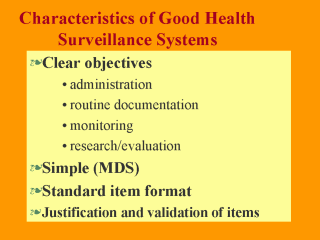| front |1 |2 |3 |4 |5 |6 |7 |8 |9 |10 |11 |12 |13 |14 |15 |16 |17 |18 |19 |20 |21 |22 |23 |24 |25 |26 |review |
 |
In principle,
the basic features of a good information system are: Clear objectives: whether it is paper-based or electronic, the system objectives have to be clear before the data is collected. Information systems may only be designed for the purposes of following administrative procedures (e.g. doctor’s accounts or patients mailing addresses) or for routine documentation (e.g. laboratory test results) or for monitoring of patterns of disease within a service or geographic area, or for research purposes (e.g. evaluating impact of health interventions). A good system is also minimalist, containing the essential data items to meet the objectives. Data items should ideally follow a know standard (regional, national or service-specific) to ensure quality and meaningful interpretations and enable comparisons. Every data item incorporated should have a justification and a purpose, or else it should be removed. |